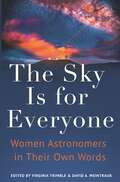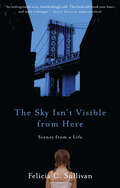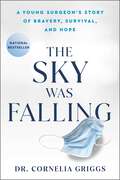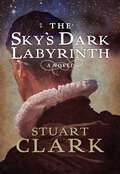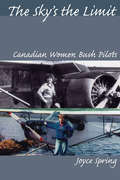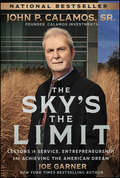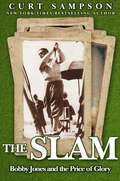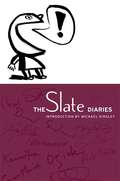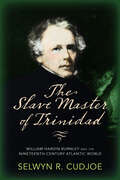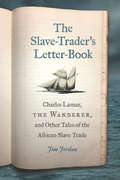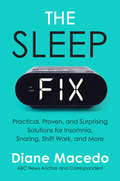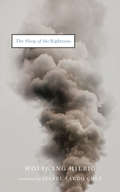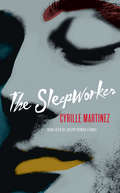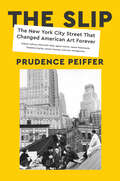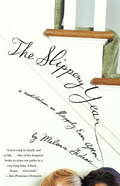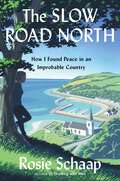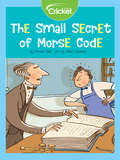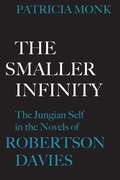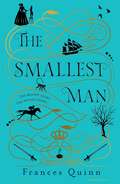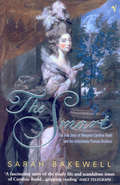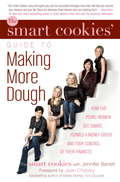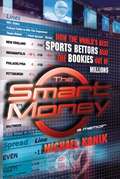- Table View
- List View
The Sky Is for Everyone: Women Astronomers in Their Own Words
by Virginia Trimble and David A. WeintraubThe Sky Is for Everyone is an internationally diverse collection of autobiographical essays by women who broke down barriers and changed the face of modern astronomy. Virginia Trimble and David Weintraub vividly describe how, before 1900, a woman who wanted to study the stars had to have a father, brother, or husband to provide entry, and how the considerable intellectual skills of women astronomers were still not enough to enable them to pry open doors of opportunity for much of the twentieth century. After decades of difficult struggles, women are closer to equality in astronomy than ever before. Trimble and Weintraub bring together the stories of the tough and determined women who flung the doors wide open. Taking readers from 1960 to today, this triumphant anthology serves as an inspiration to current and future generations of women scientists while giving voice to the history of a transformative era in astronomy. <p><p> With contributions by Neta A. Bahcall, Beatriz Barbuy, Ann Merchant Boesgaard, Jocelyn Bell Burnell, Catherine Cesarsky, Poonam Chandra, Xuefei Chen, Cathie Clarke, Judith Gamora Cohen, France Anne Córdova, Anne Pyne Cowley, Bożena Czerny, Wendy L. Freedman, Yilen Gómez Maqueo Chew, Gabriela González, Saeko S. Hayashi, Martha P. Haynes, Roberta M. Humphreys, Vicky Kalogera, Gillian Knapp, Shazrene S. Mohamed, Carole Mundell, Priyamvada Natarajan, Dara J. Norman, Hiranya Peiris, Judith Lynn Pipher, Dina Prialnik, Anneila I. Sargent, Sara Seager, Gražina Tautvaišienė, Silvia Torres-Peimbert, Virginia Trimble, Meg Urry, Ewine F. van Dishoeck, Patricia Ann Whitelock, Sidney Wolff, and Rosemary F. G. Wyse.
The Sky Isn't Visible from Here: Scenes from a Life
by Felicia C. SullivanA young woman from Brooklyn “looks at her rocky childhood growing up with a beautiful, drug-addicted mom” in this remarkable memoir (Vanity Fair). Felicia Sullivan’s mother disappeared on the night Felicia graduated from college. The daughter would go on to an Ivy League education and numerous accomplishments—but eventually, just like her missing parent, she would succumb to alcohol and cocaine abuse. In this “brave and lovely” account, Felicia looks at the ways she was shaped by the shame of her past, and how she finally overcame it (Roxana Robinson). Looking back on the tough streets of Brooklyn in the 1980s, where she lived among drug dealers, users, and substitute fathers who tended to be indifferent at best and abusive at worst, Felicia reveals how she became her mother’s keeper, taking her to the hospital when she overdosed, withstanding her narcissistic rages, and always wondering why her mother would never reveal the truth about the father she’d never met. The Sky Isn’t Visible from Here is a testament to the resilience of the human spirit, and an “extraordinary memoir [that] will keep you awake at night and haunt your dreams” (Dani Shapiro, author of Family History).
The Sky Was Falling: A Young Surgeon's Story of Bravery, Survival, and Hope
by Dr. Cornelia GriggsA NATIONAL BESTSELLER In this &“essential work that provides lasting insights and lessons for the individual and society&” (Jerome Groopman, MD, New York Times bestselling author), a young pediatric surgeon and mother reveals her dramatic, cathartic diary, written as she worked on the front lines of the COVID-19 pandemic at one of New York City&’s busiest hospitals. For many of us, the experience of the peak pandemic was eerily incongruous. We were sequestered in our quiet homes but reminded of the devastation by the never-ending ping of news alerts. Dr. Cornelia Griggs&’s experience was altogether different. A pediatric surgery fellow in New York City, she was entering the final victory lap at the end of nine grueling years of training. She was set for a big graduation celebration and looking forward to spending some real time with her husband and kids. Then came COVID-19. Initially, Griggs encouraged her friends and family not to panic. However, as mysterious cases began showing up in the hospital, and then hospital supplies started disappearing from shelves, she couldn&’t hold back the feeling that this was going to be worse than she had thought. She wrote a startling op-ed in The New York Times called &“The Sky Is Falling&” that went, for lack of a better word, viral. The piece was read by over a million people, and Griggs appeared on CNN. Having once aspired to be a journalist, Griggs found that the only way to make sense of what she was witnessing around her and maintain her sanity was to keep a diary. The Sky Was Falling is her day-to-day account of what most of us were grateful to only see in the news—the sharply increasing case numbers, the dwindling supply of respirators, the lack of clarity on how to treat this new disease. Harrowing, deeply personal, and page-turning in the way of the best medical memoirs, it tells the story of healthcare professionals who went beyond what they thought they were capable of to heal their patients, and themselves.
The Sky's Dark Labyrinth: A Novel (The\sky's Dark Labyrinth Trilogy Ser. #2)
by Stuart ClarkIntrigue and danger threaten two Renaissance astronomers in this historical novel of Galileo, Kepler, and their quest to understand the universe. At the dawn of the 17th century, it was believed that the Sun revolved around the Earth. Yet some men knew that the Heavens did not move as they should. They began to believe exactly the opposite, a heresy punishable by being burned alive. The Sky's Dark Labyrinth follows the stories of Johannes Kepler and Galileo Galilei—two men of science who pursue the light of truth into dark and dangerous territory. Kepler, a German Lutheran, was the first man to demonstrate how stars and planets moved according to mathematical laws. Galileo, an Italian Catholic, tries to claim Kepler's success for his own Church. Both men are soon enmeshed in a web of intrigue orchestrated by forces within the Vatican itself. The Sky's Dark Labyrinth is the first novel in a trilogy that explores the personal and professional struggles of these iconic figures.
The Sky's the Limit: Canadian Women Bush Pilots
by Joyce SpringThe women pilots profiled in this book have flown from British Columbia to Newfoundland and in the Northwest Territories and Nunavut. Right from the beginning of her interviews and research, the author found herself constantly amazed by the achievements of the women involved. Within the book are the stories of early Canadian women bush pilots from the late 1940s onwards. Their stories are exciting, occasionally funny, and always absorbing. Ranging from aerial surveys, water bombing of fires, flying fish, canoes and northern dogs, to the operation of a float-plane flying school, these women have left little undone. One pilot, Judy Cameron, was the first Canadian woman to be hired by an airline. Flying north of Superior, Elizabeth Wieben recalls the time that she flew naked. In pilot Suzanne Pettigrew’s own words, "We sure have come a long way and the ride was an awful lot of fun."
The Sky's the Limit: Lessons in Service, Entrepreneurship, and Achieving the American Dream
by Joe Garner John P. Calamos Sr.Stories and lessons from John P. Calamos Sr., a rags-to-riches self-made American billionaire Sky's the Limit: Lessons in service, Entrepreneurship and Achieving the American Dream tells the inspirational tale of John P. Calamos Sr., an American trailblazer, self-made success story, and living legend in the world of investing. Each chapter contains stories and business lessons he learned along the way. From a stock boy in his parents' grocery store in Chicago's west side, to 400+ combat missions in Vietnam, to launching his own firm which now has upwards of $35 billion in assets, John's career and the extreme success he's enjoyed through that career have been built on taking risks and being resilient. Some of the events detailed in this book include: Teenage John's discovery of stock certificates in his family's basement ignites a passion for investing Major Calamos' time in the Air Force, including five years of active duty flying B-52 bombers and twelve years in the Reserves flying A-37 jet fighters Pioneering initiatives to launch one of the first convertible funds in 1985 and one of the first liquid alternative funds in 1990 Sky's the Limit: Lessons in Service, Entrepreneurship and Achieving the American Dream earns a well-deserved spot on the bookshelves of all individuals seeking to mirror the success of a man who is a living embodiment of the quintessential rags-to-riches American dream.
The Slam: Bobby Jones and the Price of Glory
by Curt SampsonAn unlikely champion. An unprecedented accomplishment. A powerful story of a man on the verge of becoming a legend—at a time when the nation needed every hero it could get. In the 1930s, Bobby Jones did what no golfer had done before—and what no golfer has done since—he won all four major championships in one year. This dominant performance earned him untold riches and the adoration of the public. He had two tickertape parades to commemorate his achievement. He dated starlets. He became one of the best paid men in the country at a time when the Depression had ravaged the economy.Then, at the top of his game, he quit the sport. He walked away.One of golf's greatest writers, the New York Times bestselling author Curt Sampson, focuses on the 1930 golf season and how Bobby Jones changed a country, how Jones exemplified an era, and how his own personal demons threatened to swallow him whole, even as he performed unparalleled feats on the greens.A must-have for golf fans, THE SLAM captures the essence of an era—equal parts compelling sports biography, sweeping social history, and stirring human drama.
The Slate Diaries
by Judith Shulevitz Jodi Kantor Cyrus KroneEach week the editors of Slate, one of the on-line literary magazines, ask a different person to keep a diary. The Slate Diaries is a selection of some of the best of those diaries. Contributors include distinguished writers.
The Slave Master of Trinidad: William Hardin Burnley and the Nineteenth-Century Atlantic World
by Selwyn R. CudjoeWilliam Hardin Burnley (1780–1850) was the largest slave owner in Trinidad during the nineteenth century. Born in the United States to English parents, he settled on the island in 1802 and became one of its most influential citizens and a prominent agent of the British Empire. A central figure among elite and moneyed transnational slave owners, Burnley moved easily through the Atlantic world of the Caribbean, the United States, Great Britain, and Europe, and counted among his friends Alexis de Tocqueville, British politician Joseph Hume, and prime minister William Gladstone. In this first full-length biography of Burnley, Selwyn R. Cudjoe chronicles the life of Trinidad's "founding father" and sketches the social and cultural milieu in which he lived. Reexamining the decades of transition from slavery to freedom through the lens of Burnley's life, The Slave Master of Trinidad demonstrates that the legacies of slavery persisted in the new post-emancipation society.
The Slave-Trader's Letter-Book: Charles Lamar, The Wanderer, and Other Tales of the African Slave Trade (UnCivil Wars)
by Jim JordanLong-lost letters tell the story of an illegal slave shipment, a desperate Savannah businessman, and the lead-up to the Civil War. In 1858 Savannah businessman Charles Lamar, in violation of U.S. law, organized the shipment of hundreds of Africans on the luxury yacht Wanderer to Jekyll Island, Georgia. The four hundred survivors of the Middle Passage were sold into bondage. This was the first successful documented slave landing in the United States in about four decades, and it shocked a nation already on the path to civil war. Nearly thirty years later, the North American Review published excerpts from thirty of Lamar&’s letters, reportedly taken from his letter book, which describe his criminal activities. However, the authenticity of the letters was in doubt until very recently. In the twenty-first century, researcher Jim Jordan found a cache of private papers belonging to Charles Lamar&’s father, stored for decades in an attic in New Jersey. Among the documents was Charles Lamar&’s letter book—confirming him as the author. The first part of this book recounts the flamboyant and reckless life of Lamar himself, including involvement in southern secession, the slave trade, and a plot to overthrow the government of Cuba. A portrait emerges at odds with Lamar's previous image as a savvy entrepreneur and principled rebel. Instead, we see a man who was often broke and whose volatility sabotaged him at every turn. His involvement in the slave trade was driven more by financial desperation than southern defiance. The second part presents the &“Slave-Trader's Letter-Book.&” Together with annotations, these seventy long-lost letters shed light on the lead-up to the Civil War from the remarkable perspective of a troubled, and troubling, figure.
The Sleep Fix: Practical, Proven, and Surprising Solutions for Insomnia, Snoring, Shift Work, and More
by Diane MacedoFrom renowned ABC News anchor/correspondent and former insomniac Diane Macedo, comes a practical, user-friendly guide to getting better sleep. The Sleep Fix flips the switch on common advice, illuminating the reporter’s relentless search for how to get a good night’s sleep and the surprising, scientific, and practical solutions she found along the way. Roughly thirty percent of the population is estimated to be living with insomnia, while many more unknowingly suffer from other sleep disorders. In The Sleep Fix, Macedo aims to change that with perspective-shifting research and easy-to-implement solutions based not just on science and experts, but also her own years-long struggle. As an early-morning reporter and overnight news anchor, Macedo learned the hard way how valuable sleep is, and how it affects everything from our heart to our brain to our immune system. The longer Macedo struggled, the more her health deteriorated. Desperate, she tried standard sleep tip after standard sleep tip, but nothing worked - instead, it made her worse. Finally, after developing a tolerance to sleeping pills, Macedo decided to attack the problem as a journalist, interviewing sleep experts from all over the world to get to the bottom of what really keeps us from sleeping—and the various ways to fix it. As Macedo explains, the solution to catching zzz’s isn’t as simple as giving up caffeine, or putting away your phone before bed. With her down-to-earth explanations and humor, she instead teaches us how to: • Understand sleep biology• Identify sleep obstacles• Flag sleep myths and separate fact from fiction• Try counterintuitive approaches• Shift our mindset Most importantly, Macedo — a busy, working mom — teaches us how to adjust and fit these solutions into our everyday lives. Offering expert wisdom, cutting-edge research, intimate sleep stories from public figures, and actionable advice, The Sleep Fix is the tell-it-like-it-is guide this sleep-deprived world has been waiting for.
The Sleep Of The Righteous
by László Krasznahorkai Wolfgang Hilbig Isabel Fargo ColeDoppelgängers, a murderer’s guilt, pulp noir, fanatical police, and impossible romances--these are the pieces from which German master Wolfgang Hilbig builds a divided nation battling its demons. Delving deep into the psyches of both East and West Germany, The Sleep of the Righteous reveals a powerful, apocalyptic account of the century-defining nation’s trajectory from 1945 to 1989. From a youth in a war-scarred industrial town to wearying labor as a factory stoker, surreal confrontations with the Stasi, and, finally, a conflicted escape to the West, Hilbig creates a cipher that is at once himself and so many of his fellow Germans. Evoking the eerie bleakness of films like Tarkovsky’s Stalker and The Lives of Others, this titan of German letters combines the Romanticism of Poe with the absurdity of Kafka to create a visionary, somber statement on the ravages of history and the promises of the future.
The Sleepworker
by Cyrille Martinez Joseph Patrick Stancil"As New York, capital of the twentieth century, recedes from memory, it becomes more like Paris; we flock to it to pay tribute to the great things that once happened there. New York is now a miasma of apocryphal myths feasting on its own corpse. On these pages, Martinez spins hazy rumor and wilting gossip into blistering contemporary fiction, holding up Warhol's mirror to the myth of Warhol himself. The result is a delicious celebration of simulacra where, like New York New York itself, nothing is true, but everything is permitted."--Kenneth GoldsmithJohn is a poet. Only John almost never writes poems, because he is also unemployed. He lives with four friends, and they squat in a loft in New York New York, a fantastical city that resembles the Big Apple, but also any other city where artists live. They throw fabulous parties and practice group sodomy. That is, until John meets Andy.Andy is an artist. Well, he is if you define art as something that people don't want but the artist wants to give them anyway. A gallery owner with Tourette syndrome "discovers" his work and Andy is on his way to being famous. John, on the other hand, is hard at work at being unemployed, drinking all night and sleeping all day--which leaves him very little time for writing poems. Andy, watching him sleep, has an intriguing idea for a piece of art that he thinks will allow John to get paid for what he does best.Using the story of Andy Warhol and John Giorno and their film Sleep as a starting point, The Sleepworker reads like a Warhol film on fast-forward.Cyrille Martinez is a poet and novelist living in Paris. This is his English debut.Joseph Patrick Stancil has studied French and translation at UNC-Chapel Hill and New York University. He currently lives in New York, New York.
The Slip: The New York City Street That Changed American Art Forever
by Prudence PeifferLonglisted for the National Book Award · Shortlisted for the Apollo Book of the Year Award · A New York Times Notable Book of the YearThe never-before-told story of an obscure little street at the lower tip of Manhattan and the remarkable artists who got their start there. For just over a decade, from 1956 to 1967, a collection of dilapidated former sail-making warehouses clustered at the lower tip of Manhattan became the quiet epicenter of the art world. Coenties Slip, a dead-end street near the water, was home to a circle of wildly talented and varied artists that included Robert Indiana, Ellsworth Kelly, Agnes Martin, James Rosenquist, Delphine Seyrig, Lenore Tawney, and Jack Youngerman. As friends and inspirations to one another, they created a unique community for unbridled creative expression and experimentation, and the works they made at the Slip would go on to change the course of American art.Now, for the first time, Prudence Peiffer pays homage to these artists and the unsung impact their work had on the direction of late twentieth-century art and film. This remarkable biography, as transformative as the artists it illuminates, questions the very concept of a “group” or “movement,” as it spotlights the Slip’s eclectic mix of gender and sexual orientation, abstraction and Pop, experimental film, painting, and sculpture, assemblage and textile works. Brought together not by the tenets of composition or technique, nor by philosophy or politics, the artists cultivated a scene at the Slip defined by a singular spirit of community and place. They drew lasting inspiration from one another, but perhaps even more from where they called home, and the need to preserve the solitude its geography fostered. Despite Coenties Slip’s obscurity, the entire history of Manhattan was inscribed into its cobblestones—one of the first streets and central markets of the new colony, built by enslaved people, with revolutionary meetings at the tavern just down Pearl Street; named by Herman Melville in Moby Dick and site of the boom and bust of the city’s maritime industry; and, in the artists’s own time, a development battleground for Jane Jacobs and Robert Moses. The Slip’s history is entwined with that of the artists and their art—eclectic and varied work that was made from the wreckage of the city’s many former lives.An ambitious and singular account of a time, a place, and a group of extraordinary people, The Slip investigates the importance of community, and makes an argument for how we are shaped by it, and how it in turns shapes our work.
The Slippery Year: A Meditation on Happily Ever After
by Melanie GideonHave you ever sat across the breakfast table from your husband and wondered, "How did I get here?" Do the things that once made you complete-including your husband-now feel like a burden? Is the life you are leading an unrecognizable version of the one you imagined for yourself not so very long ago? Welcome to the world of Melanie Gideon. THE SLIPPERY YEAR chronicles a year in which Gideon confronts both the fantasies of her receding youth and the realities of midlife with a husband and a child and a dog (one of whom runs away). Marriage changes passion, Gideon confides; suddenly you're in bed with a relative (in Gideon's case, a relative with a penchant for buying residential vehicles online.) She reflects on the exigencies of family life-the need for a household catastrophe plan, the fainting spell occasioned by the departure of her nine year old son for camp. With wit, tenderness, and unsparing honesty, Gideon captures that moment in our lives when the magic starts to ebb, and when the things you have loved forever begin to fall away for the first time. It is the story of a woman's quest, in the face of all the big questions ("What's this loose skin around my knees? I don't look as old as she does, do I?") to reignite passion, beauty and mystery, and discover if 'happily ever after' is a possibility after all.
The Slow Road North: How I Found Peace in an Improbable Country
by Rosie SchaapFrom the acclaimed author of the “wonderfully funny and openhearted” (NPR) Drinking with Men comes a poignant, wrenching, and ultimately hopeful book—equal parts memoir and social history—that follows the author, after a series of tragic losses, to Northern Ireland, where she finds a path toward healing.Rosie Schaap had a solid career as a journalist and a life that looked to others like nonstop fun: all drinking and dining and traveling to beautiful places—and getting paid to write about it. But under the surface she was reeling from the loss of her husband and her mother—who died just one year apart. Caring for them had claimed much of her daily life in her late thirties. Mourning them would take longer.It wasn’t until a reporting trip took her to the Northern Irish countryside that Rosie found a partner to heal with: Glenarm, a quiet, seaside village in County Antrim. That first visit made such an impression she returned to make a life. This unlikely place—in a small, tough country mainly associated with sectarian strife—gave her a measure of peace that had seemed impossible elsewhere.Weaving personal narrative and social history, The Slow Road North is a moving and wise look at how a community can offer the key to healing. It’s a portrait of a complicated place at a pivotal time—through Brexit, a historic school integration, and a pandemic—and a love letter to a village and a culture.
The Small Secret of Morse Code
by Pamela DellWant to know about the dots and dashes of Morse code? Learn how Morse code came into being and became less time-consuming and more efficient.
The Smaller Infinity: The Jungian Self in the Novels of Robertson Davies (The Royal Society of Canada Special Publications)
by Patricia MonkThe concepts of the Jungian theory of personality have long held considerable interest for Robertson Davies, both outside his fiction and as the explicit subject of The Manticore. This interpretive study discusses Davies' use of Jungian psychology as both a structural and a thematic device and touches on related themes of illusion and the nature of reality.Drawing extensively on early reviews and articles, Monk sketches the background to Davies' preoccupation with psychology, revealing its influence on his early writings, including the effect of the Jungian concept of the persona on Shakespeare's Boy Actors and the ocncept of the shadow on the Samuel Marchbanks material. She also notes the introduction of the important themes of illusion, as a mask for reality, and ambivalence which are extended in the Salterton trilogy, Fifth Business, and The Manticore. Monk concludes that World of Wonders reveals an apparent but unsuccessful attempt on Davies' part to get away from Jungian psychology, and an exploration of alternative myths of human identity: the romance myth of the hero and the Spenglerian myth of the Magian soul.
The Smallest Lights in the Universe: A Memoir
by Sara SeagerCanadian MIT astrophysicist Sara Seager interweaves the story of her search for meaning and solace after losing her first husband to cancer, her unflagging search for an Earth-like exoplanet and her unexpected discovery of new love.Sara Seager has made it her life's work to peer into the spaces around stars--looking for exoplanets outside our solar system, hoping to find the one-in-a-billion world enough like ours to sustain life. But with the unexpected death of her husband, her life became an empty, lightless space. Suddenly, she was the single mother of two young boys, a widow at forty, clinging to three crumpled pages of instructions her husband had written for things like grocery shopping--things he had done while she did pioneering work as a planetary scientist at MIT. She became painfully conscious of her Asperger's, which before losing her husband had felt more like background noise. She felt, for the first time, alone in the universe.In this probing, invigoratingly honest memoir, Seager tells the story of how, as she stumblingly navigated the world of grief, she also kept looking for other worlds. She continues to develop groundbreaking projects, such as the Starshade, a sunflower-shaped instrument that, when launched into space, unfurls itself so as to block planet-obscuring starlight, and she takes solace in the alien beauty of exoplanets. At the same time, she discovers what feels every bit as wondrous: other people, reaching out across the space of her grief. Among them are the Widows of Concord, a group of women offering consolation and advice, and her beloved sons, Max and Alex. Most unexpected of all, there is another kind of one-in-a-billion match with an amateur astronomer. Equally attuned to the wonders of deep space and human connection, The Smallest Lights in the Universe is its own light in the dark.
The Smallest Lights in the Universe: A Memoir
by Sara SeagerIn this luminous memoir, an MIT astrophysicist must reinvent herself in the wake of tragedy and discovers the power of connection on this planet, even as she searches our galaxy for another Earth.Sara Seager has always been in love with the stars: so many lights in the sky, so much possibility. Now a pioneering planetary scientist, she searches for exoplanets—especially that distant, elusive world that sustains life. But with the unexpected death of Seager&’s husband, the purpose of her own life becomes hard for her to see. Suddenly, at forty, she is a widow and the single mother of two young boys. For the first time, she feels alone in the universe.As she struggles to navigate her life after loss, Seager takes solace in the alien beauty of exoplanets and the technical challenges of exploration. At the same time, she discovers earthbound connections that feel every bit as wondrous, when strangers and loved ones alike reach out to her across the space of her grief. Among them are the Widows of Concord, a group of women offering advice on everything from home maintenance to dating, and her beloved sons, Max and Alex. Most unexpected of all, there is another kind of one-in-a-billion match, not in the stars but here at home.Probing and invigoratingly honest, The Smallest Lights in the Universe is its own kind of light in the dark.
The Smallest Man: the most uplifting book of the year
by Frances Quinn&‘I want you to remember something, Nat. You&’re small on the outside. But inside you&’re as big as everyone else. You show people that and you won&’t go far wrong in life.&’ A compelling story perfect for fans of The Doll Factory, The Illumination of Ursula Flight and The Familiars. My name is Nat Davy. Perhaps you&’ve heard of me? There was a time when people up and down the land knew my name, though they only ever knew half the story. The year of 1625, it was, when a single shilling changed my life. That shilling got me taken off to London, where they hid me in a pie, of all things, so I could be given as a gift to the new queen of England. They called me the queen&’s dwarf, but I was more than that. I was her friend, when she had no one else, and later on, when the people of England turned against their king, it was me who saved her life. When they turned the world upside down, I was there, right at the heart of it, and this is my story. Inspired by a true story, and spanning two decades that changed England for ever, The Smallest Man is a heartwarming tale about being different, but not letting it hold you back. About being brave enough to take a chance, even if the odds aren&’t good. And about how, when everything else is falling apart, true friendship holds people together.Praise for The Smallest Man: &‘Nat Davy is so charming that I couldn't bear to put this book down. I loved it&’ Louise Hare &‘A perfect fusion of history and invention… Nat&’s wit and humour make the poignancy of his story all the more powerful&’ Beth Morrey 'What a page-turner! A timely tale celebrating courage, determination and friendship' Anita Frank &‘A perfectly formed masterpiece&’ C.S. Quinn &‘I loved this book - a fascinating tale of extraordinary accomplishment, and a story about how anything is possible and how love has always been a beacon of hope&’ Phillip Schofield 'I found myself rooting for the Smallest Man in England from the very first page' Sonia Velton &‘A beautiful, heartwarming tale, weaving history and fiction intricately and seamlessly… I loved this book&’ Louise Fein &‘This book took me on an epic journey with a character that will always have a special place in my heart&’ Emma Cooper &‘An engaging, compelling, thought-provoking story of a life less ordinary&’ Caroline Scott &‘A beguiling and well-written tale&’ Ellen Alpsten &‘I absolutely fell for the book&’s narrator: an ebullient character whose voice and world view I adored&’ Polly Crosby
The Smart
by Sarah BakewellThe Smart is a true drama of eighteenth-century life with a mercurial, mysterious heroine. Caroline is a young Irishwoman who runs off to marry a soldier, comes to London and slides into a glamorous life as a high-class prostitute, a great risk-taker, possessing a mesmerising appeal. In the early 1770s, she becomes involved with the intriguing Perreau twins, identical in looks but opposite in character, one a sober merchant, the other a raffish gambler. They begin forging bonds, living in increasing luxury until everything collapses like a house of cards - and forgery is a capital offence. A brilliantly researched and marvellously evocative history, The Smart is full of the life of London streets and shots through with enduring themes - sex, money, death and fame. It bridges the gap between aristocracy and underworld as eighteenth-century society is drawn into the most scandalous financial sting of the age.
The Smart Cookies' Guide to Making More Dough
by The Smart Cookies Jennifer BarrettThey were five dynamic young women: smart, successful - and secretly drowning in debt. Inspired by an episode of The Oprah Winfrey Show on personal finance, Andrea, Angela, Katie, Robyn, and Sandra formed a money club, together developing strategies for turning their finances around. Just one year later, they had dramatically improved their financial situations - and had made major developments in their careers, relationships, and life goals to boot. Their proven recipe for success has since been featured on The Oprah Winfrey Show and MSNBC, and in the New York Daily News. How did they do it? These five women - with varied careers in marketing, public relations, social work, and TV production - joined forces to create a fun, simple, effective strategy for achieving financial success, forming a money club, and supporting each other every step of the way. Now, in this extraordinary hands-on guide, the women, who dubbed themselves the Smart Cookies, share the secrets of their success. Weaving anecdotes from their own lives with practical how-to advice, the Smart Cookies offer strategies that cut across the financial spectrum, whether you're deeply in debt or just want to manage your money better. Tackling the unique financial challenges facing women today, they offer easy-to-follow advice on everything from creating a spending plan to boosting your income to starting your own money club.
The Smart Money
by Michael KonikA riveting inside look at the lucrative world of professional high-stakes sports betting by a journalist who lived a secret life as a key operative in the world's most successful sports gambling ring. When journalist Michael Konik landed an interview with Rick "Big Daddy" Matthews, the largest bet he'd placed on a sporting event was $200. Konik, an expert blackjack and poker player, was no stranger to Vegas. But Matthews was in a different league: the man was rumored to be the world's smartest sports bettor, the mastermind behind "the Brain Trust," a shadowy group of gamblers known for their expertise in beating the Vegas line. Konik had heard the word on the street -- that Matthews was a snake, a conniver who would do anything to gain an edge. But he was also brilliant, cunning, and charming. And when he asked Konik if he'd like to "make a little money" during the football season, the writer found himself seduced . . . So began Michael Konik's wild ride as an operative of the elite Brain Trust. In The Smart Money, Konik takes readers behind the veil of secrecy shrouding the most successful sports betting operation in America, bypassing the myths and the rumors, going all the way to its innermost sanctum. He reveals how they -- and he -- got rich by beating the Vegas lines and, ultimately, the multimillion-dollar offshore betting circuit. He details the excesses and the betrayals, the horse-trading and the paranoia, that are the perks and perils of a lifestyle in which staking inordinate sums of money on the outcome of a single event -- sometimes as much as $1 million on a football game -- is a normal part of doing business.
The Smart Money
by Michael KonikA riveting inside look at the lucrative world of professional high-stakes sports betting by a journalist who lived a secret life as a key operative in the world's most successful sports gambling ring. When journalist Michael Konik landed an interview with Rick "Big Daddy" Matthews, the largest bet he'd placed on a sporting event was $200. Konik, an expert blackjack and poker player, was no stranger to Vegas. But Matthews was in a different league: the man was rumored to be the world's smartest sports bettor, the mastermind behind "the Brain Trust," a shadowy group of gamblers known for their expertise in beating the Vegas line. Konik had heard the word on the street -- that Matthews was a snake, a conniver who would do anything to gain an edge. But he was also brilliant, cunning, and charming. And when he asked Konik if he'd like to "make a little money" during the football season, the writer found himself seduced . . . So began Michael Konik's wild ride as an operative of the elite Brain Trust. In The Smart Money, Konik takes readers behind the veil of secrecy shrouding the most successful sports betting operation in America, bypassing the myths and the rumors, going all the way to its innermost sanctum. He reveals how they -- and he -- got rich by beating the Vegas lines and, ultimately, the multimillion-dollar offshore betting circuit. He details the excesses and the betrayals, the horse-trading and the paranoia, that are the perks and perils of a lifestyle in which staking inordinate sums of money on the outcome of a single event -- sometimes as much as $1 million on a football game -- is a normal part of doing business.
